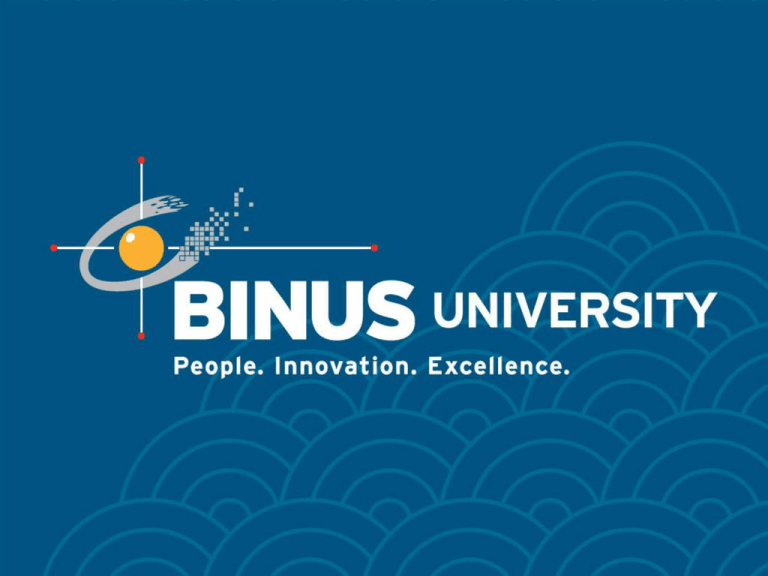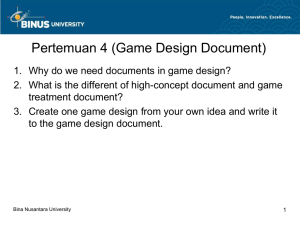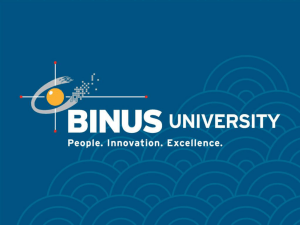Document 15114121
advertisement

Matakuliah Tahun : A0814/Investment Analysis : 2009 THE STRATEGIC ROLE OF TECHNOLOGIES Pertemuan 5-6 Why is Strategy in IT Planning Important? • IT is a tool, and when used in the context of a sound business strategy, can yield significant payoff. • Peter G.W. Keen – difference in competitive and economic benefits that firms gain from information technology rests on a management difference and not on a technology difference • The technology generally available to other competitors as well, yet some organizations reap far greater payoffs. Similar to the strategy of the arrangement of pieces on a chessboard, the management difference constitutes placing pieces of technology in the pursuit of a strategic objective. Bina Nusantara University 3 Why is Strategy in IT Planning Important? • Example: – Gas stations that offered customers the ability to pay by a charge card at the pump. There was no new technology involved in in this service; it was merely extending the card-charging service that was available inside the glass doors to the gas pump. The result : customer were happier because they did not have to go inside and stand in line. The gas stations’ cost was low because they did not have to hire more gas attendants to accept payment. Yet, in those early days, gas stations with this facility were charging a few pennies more per gallon. That’s the payoff of reconfiguring an existing technology Bina Nusantara University 4 Why is Strategy in IT Planning Important? • Example – Pizza Hut, a popular chain of restaurants, linked their telephone caller identification (ID) facility to a personal computer-based database. As the call came in, the number from their caller ID retrieved the customer’s name and address, including driving directions, purchase history, and even preferences. The result: customers referred to by name were impressed, the time to take the order was significantly reduced because address and directions did not need to be asked, and additional sales were generated when the person taking the order prompted for additional items. What is Strategy? • Michael Porter: – Businesses need to get back to using It as part of corporate strategy as opposed to an inward-looking operational role. – He also places the responsibility on the IT professionals to know the customer, to understand the manufacturing process, and to take a business view of the company? Porter’s Five Market Force IT Investment Strategy • IT investment should be managed by the strategic goals of the company. • The business strategy should be realigned when a new technology is recognized or when a new business opportunity arises. Developing A Strategy • A business should assess the state of the competition and its position in the marketplace. • Looking inward and assessing its own strengths and weaknesses will allow the organization to recognize a successful strategy. • Management decide how it wants to stake its pace in the market. • For each set of options in the strategy should be studied by examining the risks and opportunity associated. • Many an investment has been abandoned because more attention was placed on the risks and not enough on future opportunities. Looking Outward • Based on Porter’s Five Force – The threat of substitute products can change the competitive nature of the industry. – Threat of new competitiors entering the market can change the rules of the market. – New competitiors usually come with new ideas, revised paradigms, and like the revolutionaries, are dissatisfied with the way the industry operates. Due to dissatisfaction with the pricing of IT services lack of IT’s link with business strategy, and opportunity to stay technologically current has led many IT professionals to break off and compete with their former mentors and employers. Looking Outward – The intensity of rivalry among competitors is an indication of the rough road ahead for a business looking to make it in a new industry. – New entrant have a novel idea or approach to gaining customers, or a remedy for the weaknesses of the industry. – The buying power of customer and suppliers can affect the nature of competition. Bina Nusantara University 11 Looking Inward • SWOT Analysis – To match the internal strength with opportunities of the industry and create something of value. • Porter’s value chain analysis (VCA) – Provides a framework to examine each area of the business that can be targeted for IT Investment. Bina Nusantara University 12 Value Chain Bina Nusantara University 13 Value Chain • Inbound logistics, evaluates the process of inbound activites such as raw material to convert to finished products, inventory for processing, or deposits in the case of a financial institution. • In some cases, the inbound activity involves human intellectual activity such as a computer program or remote monitoring and diagnostics, or data processing. Bina Nusantara University 14 Value Chain • Operations activity involves receiving the inbound raw materials and executing the process of converting them into finished products. • Outbound logistics involves efficiently dispatching finished products and services out of operations to the customers. • Marketing and sales can offer significant opportunities for IT investment payoff. Targeted advertising and market research, developing sales leads, and managing customer relationship are some examples of IT based initiatives Bina Nusantara University 15 What To Look For • The impact of IT investment is not always evident in the profitability of the firm. • The payoff can be reflected in other ways such as higher efficiency or increased customer value. Bina Nusantara University 16 Lorin Hitt Research • Lorin Hitt of the Wharton School at the University of Pennsylvania and Erik Brynjolfsson of the Massachusetts Institute of Technology found that IT has increased productivity and created substantial value for customers. • They found that there is no inherent contradiction between increased productivity, increased consumer value, and unchanged business profitability, because in competitive industries businesses may pass on the savings from improved productivity to their customers. • An understanding of how and whom technology is likely to affect will lead to useful metrics of IT payoff. Bina Nusantara University 17



